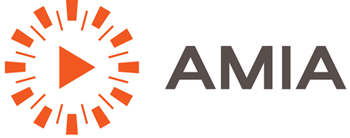Poster Sessions

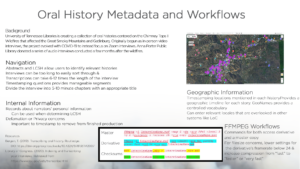 Poster: Oral History Metadata: Lessons from a Wildfire Oral History
Poster: Oral History Metadata: Lessons from a Wildfire Oral History
Drew Edwards, University of Tennessee Libraries
Transcription work can take six or more hours for each single hour of recording. By planning what metadata should be created, access points for an oral history can still be maintained even when there is neither time or budget for transcriptions. Dividing the history into chapters that are five to ten minutes, provides much more manageable segments for researchers; also useful is timestamping the questions asked of the narrator, though this is much more dependent upon the interviewer. Another goal was to capture locations discussed in each history. GeoNames proved a useful controlled vocabulary for this. Being crowdsourced, users are able to input any location they wish with appropriate coordinates and other details. This provides a level of granularity that is not present in other resources; specific roads and buildings can be noted that highlight the route of narrators and crucial locations post fire like relief centers.
![]()
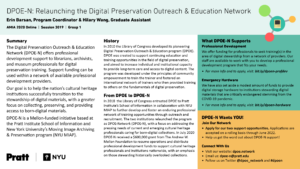 Poster: DPOE-N: Relaunching the Digital Preservation Outreach & Education Network
Poster: DPOE-N: Relaunching the Digital Preservation Outreach & Education Network
Erin Barsan (she/her), Pratt Institute, Program Coordinator
Hilary Wang, Pratt Institute School of Information, Graduate Student
DPOE-N: Relaunching the Digital Preservation Outreach & Education Network, will present the work underway at Pratt Institute and New York University’s Moving Image Archiving and Preservation program on the Digital Preservation Outreach and Education Network (DPOE-N): a network of training resources available to cultural heritage professionals in the United States and US territories with a significant focus on outreach. Pratt and NYU took over DPOE from the Library of Congress in 2018, thanks to a generous grant from the Mellon Foundation in 2020, they have resumed operations on this important initiative. This poster will highlight the initiative of DPOE-N to provide funding and support to cultural heritage professionals and institutions for digital preservation training, as well as emergency hardware support in response to the COVID-19 pandemic.
![]()
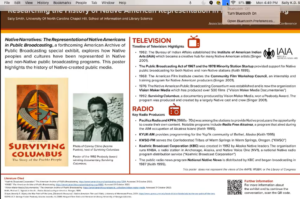 Poster: Researching the Evolution of Native American Representation in Public Broadcasting
Poster: Researching the Evolution of Native American Representation in Public Broadcasting
Sally Smith, Student
Native Narratives: The Representation of Native Americans in Public Broadcasting, a forthcoming American Archive of Public Broadcasting (AAPB) online exhibit, explores how Native American peoples and cultures have been represented both in non-Native-produced and Native-created public broadcasting programs in the AAPB collection. This poster, ?Researching the Evolution of Native American Representation in Public Broadcasting,? summarizes the research behind the exhibit such as the origins and continued pervasiveness of Native American stereotypes; public news coverage of the United States policies of termination, tribal restoration and urban relocation; the history of Native owned-and- operated public broadcasting companies; and the types of media made by and for Native Americans.
![]()
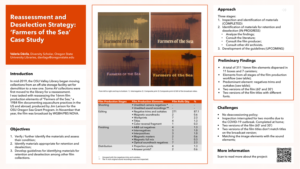 Poster: Reassessment and Deselection Strategy: “Farmers of the Sea” Case Study
Poster: Reassessment and Deselection Strategy: “Farmers of the Sea” Case Study
Valeria Davila Gronros, Oregon State University Libraries and Press
In mid-2019, the Oregon State University Valley Library began preparations to move the collections stored at an old off-site storage facility, set for demolition, to a new facility. The audiovisual collections were first temporarily moved to the library for reassessment, as identifying the materials appropriate for retention and for deselection would improve access to the collection. In this context, I’m reassessing the production elements of “Farmers of the Sea” (Jim Larison, 1984), a 16mm film documenting aquaculture practices in the US and abroad. By focusing on the approach, challenges, and preliminary findings of the project, this poster will inform and ignite conversation on audiovisual reassessment and deselection with other professionals going through similar processes at their institutions, especially at academic archives, and the larger community.
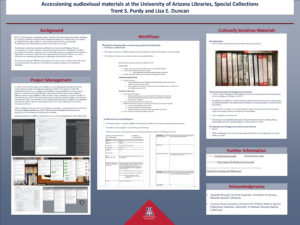 Poster: Accessioning audiovisual materials at the University of Arizona Special Collections
Poster: Accessioning audiovisual materials at the University of Arizona Special Collections
Trent Purdy, University of Arizona Libraries, Special Collections
This poster presentation proposal covers the University of Arizona Libraries Special Collections newly implemented audiovisual accession workflow. Audiovisual materials in of themselves pose unique problems for archivist for access and preservation so new workflows were created that help determine processing and preservation priorities which align of the mission of Special Collections. Audiovisual specific accession forms are used to identify audiovisual specific needs and oral history materials and indigenous materials that may need further assessment for privacy and culturally sensitive materials. The development of these accession workflows lead to the development of additional policy and procedures related to oral history materials and continued development of relationships with the local Native American tribes to appropriately preserve and provide access to prioritized Native American materials in accordance with the Protocols for Native American Materials adopted by Special Collections.
![]()
 Poster: Enhancing Access to “In Black America” on Wikipedia
Poster: Enhancing Access to “In Black America” on Wikipedia
Declan McBride, GBH
This presentation will focus on increasing access to KUT’s “In Black America” radio series, a nationally syndicated program hosted by John L. Hanson Jr. The program profiles civil rights leaders, artists and journalists, in order to call attention to the experiences of people of color. In spite of airing for 50 years, the collection lacks sufficient metadata, which I am creating in accordance with PBCore, along with creating external links to the archived programs on the Wikipedia pages of guests, in addition to hosting a Wikipedia Edit-a-thon to engage public volunteers. Many Wikipedia pages for Black, indigenous and other people of color are often not as robust compared to those of white people, particularly lacking adequate linked archival sources. This project increases the ease of access to the database of the American Archive of Public Broadcasting. by meeting users where they are, while also increasing the visibility of these figures.
![]()
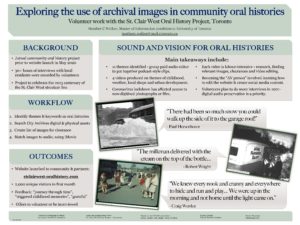 Poster: Exploring the use of archival images in community oral histories
Poster: Exploring the use of archival images in community oral histories
Heather Walker, University of Toronto, Graduate Student
Oral histories are a powerful archival record, allowing us to vividly imagine the stories and memories of the speaker. As a volunteer with a local oral history group in Toronto, I searched for archival photographs and moving images to compliment the themes found in their stories. By adding these visual elements to the audio recordings, I created short videos that aim to represent the geographic and temporal feel of the recorded interviews, and engage our online community audience in new ways.
![]()
 Poster: Library of Congress Recommended Format Statement 2.0: Purpose, Process, Impact
Poster: Library of Congress Recommended Format Statement 2.0: Purpose, Process, Impact
Laura Drake Davis, Library of Congress
A resource for digital collections of all sizes, the 2020-2021 Recommended Formats Statement (RFS 2.0) is the product of a new, transparent process to assess analog and digital formats suitable for preservation. This poster will include: a brief introduction to the Recommended Format Statement; how RFS 2.0 can be utilized in moving image archives of all sizes the process for developing the Recommended Format Statement for analog and digital moving image formats; the need for the Recommended Format Statement to include commercial, open source, and industry formats; how these formats map to the Levels of Preservation and the Library of Congress Sustainability of Digital Formats website; and how subject matter experts at the Library of Congress collaborated on the evaluation of formats.
 Poster: Action In The Street: DIY Guide to Performing & Archiving
Poster: Action In The Street: DIY Guide to Performing & Archiving
David I. Griess, HUMAN TRASH DUMP
Public performance art actions are often overlooked as a form of protest by the general population. These actions are often unsanctioned and spontaneous, and because of this, they are often not recorded, archived, or publicly accessible. Performance art itself is an inherently political form of art because the human body is the primary medium. Because of this, there are risks due to local or state laws, angry public members, and law enforcement that might attempt to cause bodily harm, fine, or imprison performance markers. Action In The Street: A Guide to Performing & Archiving Public Exchange introduces a DIY approach and resources for staging, preserving, and disseminating these types of works to a broader public audience and beyond a singular action in time. archive.org/details/actioninthestreet
![]()
 Poster:: Afternoon of “El Satario”: Working on an Unidentified Print
Poster:: Afternoon of “El Satario”: Working on an Unidentified Print
Leonardo Gomes, Ryerson University
Found within the collection of The ArQuives, Toronto’s queer archives, the early pornographic film “El satario” is believed to have been produced in Argentina, between 1907 and 1912, as established by the Kinsey Institute, based on scant evidence, which is rarely contested. Thus, it has become largely considered to be the oldest extant pornographic film, although its date of production has never been confirmed. My work investigates what can be expanded from the initial finding of an unidentified print and the path that I followed in my attempt to understand the social, cultural, and technical contexts behind the film’s production, circulation, and reception. It is divided into four different sections, each dealing with a broad theme that contributes to unraveling the mysteries of ƒ??El satario,ƒ? as well as providing both the reader and the researcher with a broader understanding of the film itself and of what revolves around it.
![]()
 Poster: Brandon Films and the 16mm Distribution Sector’s Paper Remains
Poster: Brandon Films and the 16mm Distribution Sector’s Paper Remains
Tanya Goldman, New York University
Drawing primarily from company catalogs and rare promotional ephemera, this poster highlights the operations of prominent mid-twentieth century 16mm distribution company Brandon Film and the activities of its founder and president Tom Brandon. The materials demonstrate how film catalogs are historical archives unto themselves, as records of products and prosaic business practices as well as sourcebooks of cultural and use value. Using Brandon Films as a case study, the poster advocates for archivists and historians to develop strategies to recover and preserve industrial histories of the 16mm rental sector by making use of both moving image and paper-based assets.
![]()
 Poster: Data-Driven Methods for Understanding the Development of Independent Media Archives
Poster: Data-Driven Methods for Understanding the Development of Independent Media Archives
Lindsay Mattock, University of Iowa School of Library and Information Science
Poster: Preserving Guerilla TV: Providing Access to Top Value Television’s Archives
Michael Campos-Quinn, UC Berkeley Art Museum & Pacific Film Archive
Top Value Television (TVTV) was a group of activist-artists working with early portable video equipment from 1972 to 1977. They began with guerrilla TV coverage of the 1972 Democratic and Republican presidential conventions, and went on to produce McLuhan-inflected critiques of mass media. BAMPFA has digitized 450 half-inch open reel, camera-original tapes from TVTV’s political documentaries, THE WORLD’S LARGEST TV STUDIO and FOUR MORE YEARS (both 1972) and GERALD FORD’S AMERICA (1974), as well as TVTV’s paper collection. This poster discusses BAMPFA’s digitization project as a means to advocate for future preservation projects documenting alternative and underground American culture.
![]()
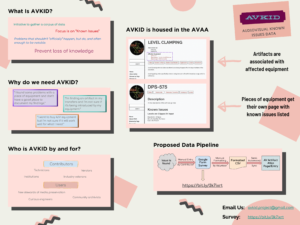 Poster: The Audio Video Known Issues Data (AVKID) Initiative
Poster: The Audio Video Known Issues Data (AVKID) Initiative
Dan Hockstein, University of North Carolina at Chapel Hill
AVKID is a new initiative to gather a corpus of “known issues” found with equipment commonly used in A/V preservation efforts. The focus is on safekeeping and subsiding the loss of knowledge that technicians and professionals might have, documented informally in forums, databases, and brains across the globe.
